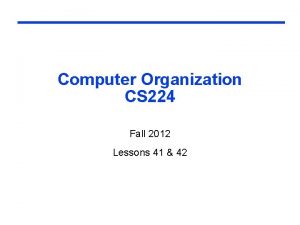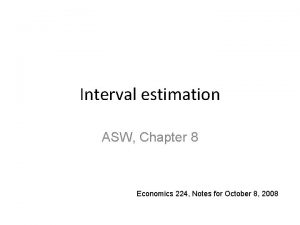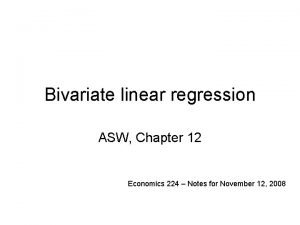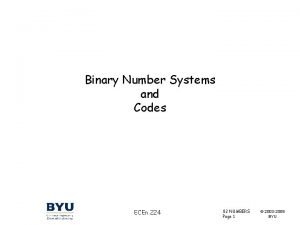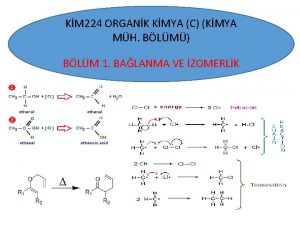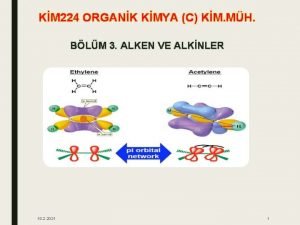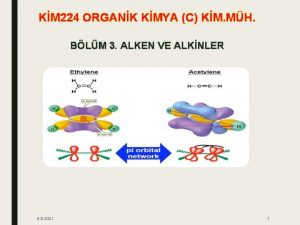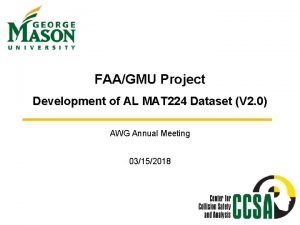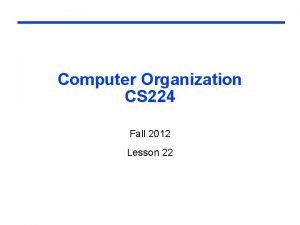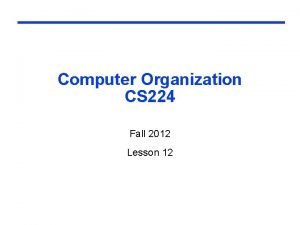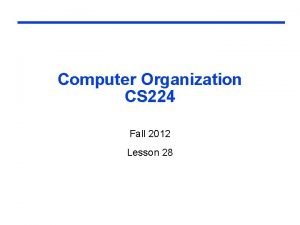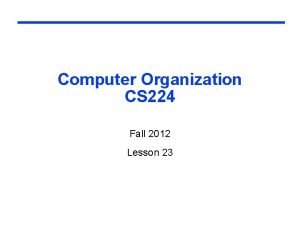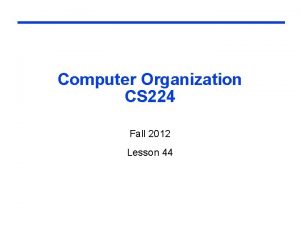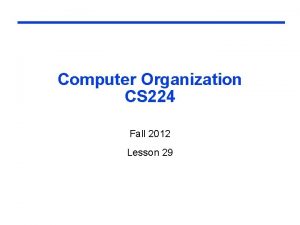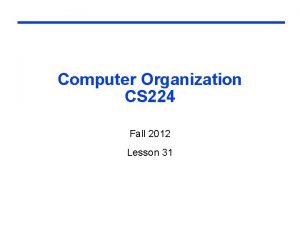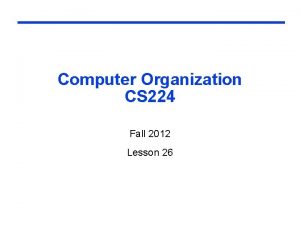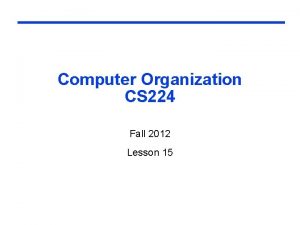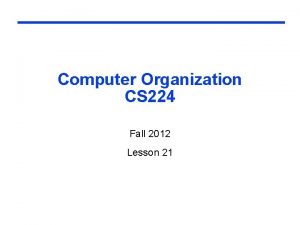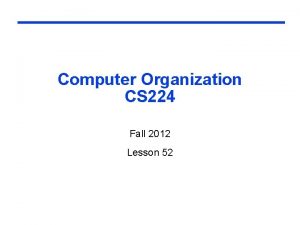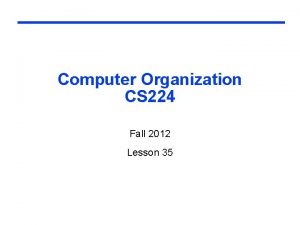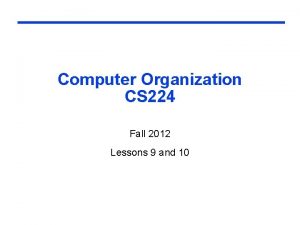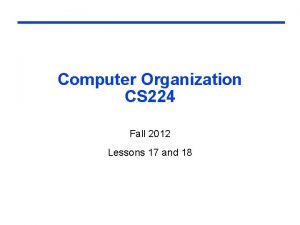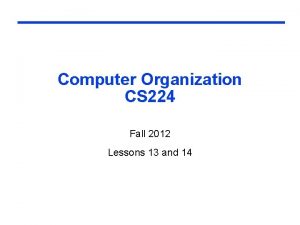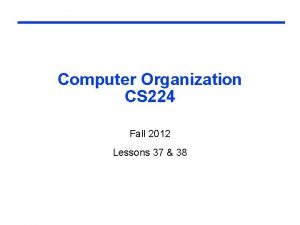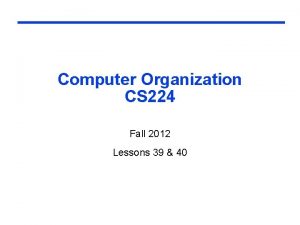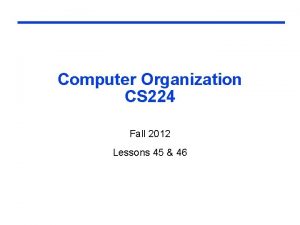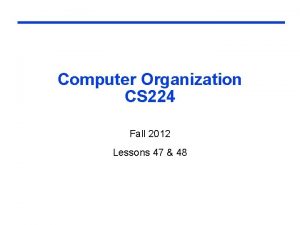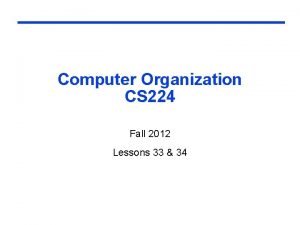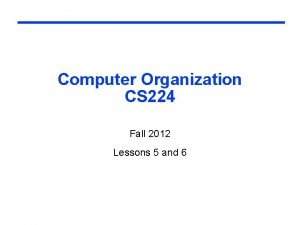Computer Organization CS 224 Fall 2012 Lesson 52

























- Slides: 25

Computer Organization CS 224 Fall 2012 Lesson 52

q Each processor has private physical address space q Hardware sends/receives messages between processors § 7. 4 Clusters and Other Message-Passing Multiprocessors Message Passing

Loosely Coupled Clusters q Network of independent computers l Each has private memory and OS l Connected using I/O system - E. g. , Ethernet/switch, Internet q Suitable l for applications with independent tasks Web servers, databases, simulations, … q High availability, scalable, affordable q Problems Administration cost (prefer virtual machines) l Low interconnect bandwidth l - c. f. processor/memory bandwidth on an SMP

Sum Reduction (Again) q Sum 100, 000 on 100 processors q First distribute 1000 numbers to each l Then do partial sums sum = 0; for (i = 0; i<1000; i = i + 1) sum = sum + AN[i]; q Reduction Half the processors send, other half receive & add l Then a quarter send, other quarter receive & add, … l

Sum Reduction (Again) q Using send() and receive() operations limit = 100; half = 100; /*100 processors*/ repeat half = (half+1)/2; /* send vs. receive dividing line */ if (Pn >= half && Pn < limit) send(Pn - half, sum); if (Pn < (limit/2)) sum = sum + receive(); limit = half; /*upper limit of senders*/ until (half == 1); /*exit with final sum*/ q With odd #, middle element stays out, becomes upper limit in next iteration q Send/receive also provide synchronization q Assumes send/receive take similar time to addition

Grid Computing q Separate networks computers interconnected by long-haul E. g. , Internet connections l Work units farmed out, results sent back l q Can l make use of idle time on PCs E. g. , SETI@home, World Community Grid

Multiprocessor Programming q q Unfortunately, writing programs which take advantage of multiprocessors is not a trivial task l Inter-processor communication required to complete a task l Traditional tools require that the program understand the specifics of the underlying hardware l Amdahl’s law limits performance due to a lack of inherent parallelism in many applications Given these issues, a limited number of applications have been rewritten to take advantage of multiprocessor systems l Examples: Databases, file servers, CAD, MP OSes

q q q Performing multiple threads of execution in parallel l Replicate registers, PC, etc. l Fast switching between threads Fine-grain multithreading l Switch threads after each cycle l Interleave instruction execution l If one thread stalls, others are executed Coarse-grain multithreading l Only switch on long stall (e. g. , L 2 -cache miss) l Simplifies hardware, but doesn’t hide short stalls (eg, data hazards) § 7. 5 Hardware Multithreading

Types of Multithreading q Fine-grain – switch threads on every instruction issue l l q Round-robin thread interleaving (skipping stalled threads) Processor must be able to switch threads on every clock cycle Advantage – can hide throughput losses that come from both short and long stalls Disadvantage – slows down the execution of an individual thread since a thread that is ready to execute without stalls is delayed by instructions from other threads Coarse-grain – switches threads only on costly stalls (e. g. , L 2 cache misses) l l Advantages – thread switching doesn’t have to be essentially free; this method is much less likely to slow down the execution of an individual thread Disadvantage – limited, due to pipeline start-up costs, in its ability to overcome throughput loss, since pipeline must be flushed and refilled on thread switches

Simultaneous Multithreading (SMT) q In multiple-issue dynamically scheduled processor l Schedule instructions from multiple threads l Instructions from independent threads execute when function units are available l Within threads, dependencies handled by scheduling and register renaming q Example: l Intel Pentium-4 (w/ Hyper. Threading) Two threads: duplicated registers, shared function units and caches

Multithreading Example

Future of Multithreading q Will it survive? In what form? considerations simplified microarchitectures q Power l Simpler forms of multithreading q Tolerating l cache-miss latency Thread switch may be most effective q Multiple simple cores might share resources more effectively

q An alternate classification—Flynn’s taxonomy Data Streams Single Instruction Single Streams Multiple n Multiple SISD: Intel Pentium 4 SIMD: SSE instructions of x 86 MISD: No examples today MIMD: Intel Xeon e 5345 SPMD: Single Program Multiple Data n n A parallel program on a MIMD computer Conditional code for different processors § 7. 6 SISD, MIMD, SPMD, and Vector Instruction and Data Streams

SIMD q Operate element-wise on vectors of data l E. g. , MMX and SSE instructions in x 86 - Multiple data elements in 128 -bit wide registers q All processors execute the same instruction at the same time l Each with different data address, etc. q Simplifies synchronization q Reduced instruction control hardware q Works best for highly data-parallel applications

Vector Processors q Highly pipelined function units q Stream data from/to vector registers to units Data collected from memory into registers l Results stored from registers to memory l q Example: Vector extension to MIPS 32 × 64 -element registers (64 -bit elements) l Vector instructions l - lv, sv: load/store vector - addv. d: add vectors of double - addvs. d: add scalar to each element of vector of double q Significantly reduces instruction-fetch bandwidth

Example: DAXPY (Y = a × X + Y) Conventional MIPS code (loops 64 times) l. d $f 0, a($sp) ; load scalar a addiu r 4, $s 0, #512 ; upper bound of what to load loop: l. d $f 2, 0($s 0) ; load x(i) mul. d $f 2, $f 0 ; a × x(i) l. d $f 4, 0($s 1) ; load y(i) add. d $f 4, $f 2 ; a × x(i) + y(i) s. d $f 4, 0($s 1) ; store into y(i) addiu $s 0, #8 ; increment index to x addiu $s 1, #8 ; increment index to y subu $t 0, r 4, $s 0 ; compute bound bne $t 0, $zero, loop ; check if done q Vector MIPS code (NO loop) l. d $f 0, a($sp) ; load scalar a lv $v 1, 0($s 0) ; load vector x mulvs. d $v 2, $v 1, $f 0 ; vector-scalar multiply lv $v 3, 0($s 1) ; load vector y addv. d $v 4, $v 2, $v 3 ; add y to product sv $v 4, 0($s 1) ; store the result q

Vector vs. Scalar q Vector architectures and compilers l Simplify data-parallel programming l Explicit statement of absence of loop-carried dependences - Reduced checking in hardware l Regular access patterns benefit from interleaved and burst memory l Avoid control hazards by avoiding loops q More general than ad-hoc media extensions (such as MMX, SSE) l Better match with compiler technology

q Early l video cards Frame buffer memory with address generation for video output q 3 D graphics processing Originally high-end computers (e. g. , SGI) l Moore’s Law lower cost, higher density l 3 D graphics cards for PCs and game consoles l q Graphics Processing Units Processors oriented to 3 D graphics tasks l Vertex/pixel processing, shading, texture mapping, rasterization l § 7. 7 Introduction to Graphics Processing Units History of GPUs

Graphics in the System

Graphics Processing Units (GPUs) Initially GPUs were accelerators to supplement a CPU so they didn’t need to be able to perform all of the tasks of a CPU. They dedicated all of their resources to graphics q Programming interfaces free from backward binary compatibility constraints resulted in more rapid innovation in GPUs than in CPUs q Original GPU data types: vertices (x, y, z, w) coordinates and pixels (red, green, blue, alpha) color components q GPUs execute many threads (e. g. , vertex and pixel shading) in parallel – lots of data-level parallelism q

GPU Architectures q Processing is highly data-parallel l l GPUs are highly multithreaded Use thread switching to hide memory latency - Less reliance on multi-level caches l q Trend toward general purpose GPUs l l q Graphics memory is wide and high-bandwidth Heterogeneous CPU/GPU systems CPU for sequential code, GPU for parallel code Programming languages/APIs l l l APIs: Direct. X, Open. GL High level graphics shading languages: C for Graphics (Cg), High Level Shader Language (HLSL) Compute Unified Device Architecture (CUDA)

Typical GPU Architecture Features q Rely on having enough threads to hide the latency to memory (not caches as in CPUs) l q Use extensive parallelism to get high performance l l q Have extensive set of SIMD instructions; GPUs are multicore (multiple GPU processors on a chip) Main memory is bandwidth, not latency, driven l q Each GPU is highly multithreaded GPU DRAMs are wider and have higher bandwidth than CPU memories, but are typically smaller in capacity Leaders in the marketplace l l l NVIDIA: Ge. Force 8800 GTX (16 multiprocessors each with 8 multithreaded processing units) AMD: ATI Radeon and ATI Fire. GL Intel, others, trying to break in

Example: NVIDIA Tesla Streaming multiprocessor 8 × Streaming processors

Example: NVIDIA Tesla q q Streaming Processors l Single-precision FP and integer units l Each SP is fine-grained multithreaded Warp: group of 32 threads l Executed in parallel, SIMD style - 8 SPs × 4 clock cycles l Hardware contexts for 24 warps - Registers, PCs, …

Classifying GPUs q Don’t fit nicely into SIMD/MIMD model l Conditional execution in a thread allows an illusion of MIMD - But with performance degredation - Need to write general-purpose code with care Instruction-Level Parallelism Data-Level Parallelism Static: Discovered at Compile Time Dynamic: Discovered at Runtime VLIW Superscalar SIMD or Vector Tesla Multiprocessor
 Cs-224 computer organization
Cs-224 computer organization Process organization in computer organization
Process organization in computer organization Basic structure of a computer
Basic structure of a computer Difference between architecture and organization
Difference between architecture and organization Interrupt cycle flow chart
Interrupt cycle flow chart Basic computer organization
Basic computer organization Aci crack repair
Aci crack repair Kohlbergs stages
Kohlbergs stages Embolie pulmonaire item
Embolie pulmonaire item Asw 224
Asw 224 Ece224
Ece224 Bivariate linear regression
Bivariate linear regression Alchinele contin in molecula lor legaturi pi
Alchinele contin in molecula lor legaturi pi Cs 224
Cs 224 Binary 224
Binary 224 Stanford cs 224w
Stanford cs 224w Soc 224
Soc 224 Km 224
Km 224 Uç alkin nedir
Uç alkin nedir Oksimerkürasyon
Oksimerkürasyon Km 224
Km 224 Mat 224
Mat 224 Ece 224
Ece 224 Dea form 224
Dea form 224 224+48
224+48 224+48
224+48
